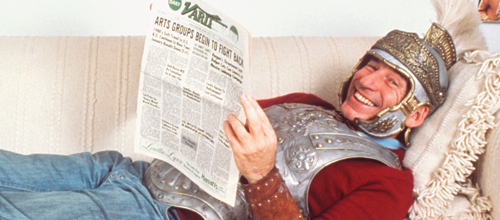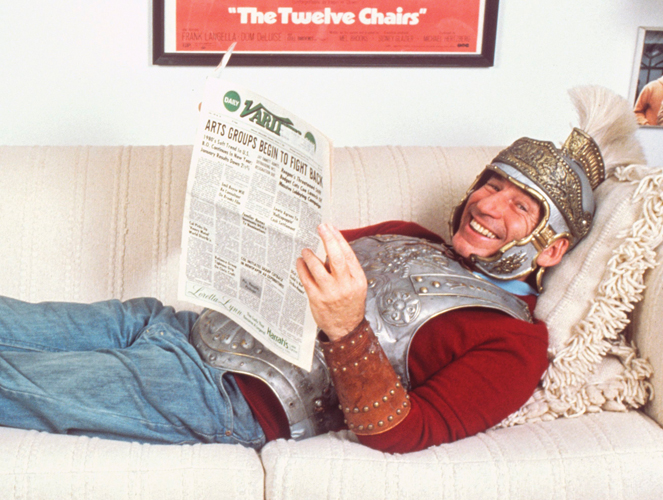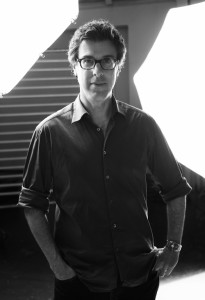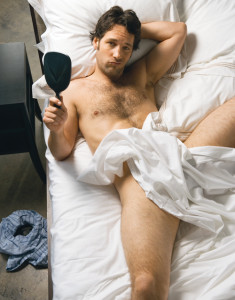
Right on Track

Director/photographer Robert Trachtenberg talks about his new Mel Brooks documentary, how he got Paul Rudd to drop his boxers, and more.
by Blase DiStefano
Robert Trachtenberg is an award-winning photographer, filmmaker, and bestselling author whose latest documentary for the American Masters series is Mel Brooks: Make a Noise (airing this month on PBS). • “When they called me to say I had been chosen as the next ‘American Master,’” says Mel Brooks, “I thought they said I was chosen to be the next Dutch Master. So I figured, what the hell—at least I’ll get a box of cigars. When I realized my mistake, I was both elated and a little disappointed at losing the cigars.” Trachtenberg says, “I asked him deep, probing questions for four months, and he got to keep the shirt we bought for him. So I think we both made out pretty well.” • Trachtenberg’s past films for American Masters include On Cukor (2000), about director George Cukor; Gene Kelly: Anatomy of a Dancer (2002); and the Emmy-nominated Cary Grant: A Class Apart (2005). For the Brooks doc, Trachtenberg interviewed Cloris Leachman, Joan Rivers, Nathan Lane, Tracey Ullman, Matthew Broderick, Carl Reiner, and many others. • Trachtenberg has photographed Meryl Streep, Jon Stewart, Amy Poehler, Justin Bieber, Sarah Silverman, the cast of The New Normal, Adam Lambert, Taylor Swift, Bradley Cooper, and the cast of Glee, to name a very few.

Blase DiStefano: How long did it take to put this American Masters documentary together?
Robert Trachtenberg: From start to finish, about a year.
What was it like trying to gather all the celebrities for interviews, and was there anyone you tried to get who wasn’t available?
This was a unique experience—the minute celebrities heard it was for Mel, they didn’t hesitate. The only person we couldn’t get was Gene Wilder, who I had worked with in the past, but has essentially retired. [Editor’s note: there are clips from an interview and from films of Gene Wilder in the documentary. Most are memorable.]
What was the average time you spent with each of the interviewees?
Depending on their involvement in Mel’s life or career, anywhere from an hour on up. Obviously, someone like Carl Reiner, who’s known him for over sixty years, took a bit more time.
How did you get Mel Brooks to do this?
I didn’t. American Masters did all the legwork, and they asked me to do the film.
How much time did you spend with him?
We spent approximately thirty hours over the course of four months doing interviews. It was just a pleasure to hear him tell stories—this easily could’ve been a four-hour film of just Mel talking. The crew was so happy at the end of each day.
I think you›re going to be surprised at what you learn about Mel—work you didn›t even know he had a hand in. And you should definitely watch all the way through the end credits, because even they’re funny.

Now, about you: I had no idea you are such a fantastic photographer. I went to your website, and I was amazed at the quality and quantity of photos. When and how did being a photographer come about?
Oh, thanks. I’ve been a photographer for quite a while. The directing came afterwards. I worked for a celebrity photographer for a number of years in a variety of capacities, and finally thought I ought to give it a try on my own.
You’ve photographed a slew of celebs. Who have you not photographed that you would like to snap?
Anyone who brings something to the table, who really engages in the whole process and doesn’t just stand there.
The photo of Maggie Smith [on your website] is gorgeous. Tell me about the photo shoot with her.
Well, funny I just said the above, because she just stood there. But there was a good reason: I had her for three minutes between shots, and being in costume, she stayed in character [as Violet Crawley, Dowager Countess of Grantham, in Downton Abbey]—and that character would not be smiling and jumping around.
Tell me about the photos of Melissa McCarthy as Divine and Paul Rudd in bed.
Well, with Melissa we were doing her as different Queens—and Divine seemed like the natural Queen of Drag, and she was immediately into it. Paul was really terrific—he got the humor of the idea, and then was kind enough to drop his boxers and inch the sheet up to make the joke work visually.
In your book, When I Knew, celebrities tell when they first knew they were gay. When did you first know?
Always.

When you told your parents, what was their reaction?
My parents were totally cool, and I have no coming-out story, which is why I put When I Knew together. I had heard all these great anecdotes and thought they should be collected. I wanted to focus on the humorous, touching side of coming out. The goal was a book you could leave on your coffee table so when your parents came over, they could pick it up and laugh and/or cry.
Does being gay affect the way you work?
Being gay has no bearing on the way that I work, or the subject matter I choose to work on. The one continuous thread that runs through all the subjects I’ve done documentaries on—Gene Kelly, Cary Grant, George Cukor, Irving Thalberg, and now Mel Brooks—is that they all have an unbelievable work ethic. They’ve all come from humble beginnings and pulled themselves up by their bootstraps to achieve their goals. That never gets old.
Mel Brooks: Make a Noise premieres nationally on PBS on Monday, May 20, at 8 p.m., and repeats Tuesday, May 21, 10 p.m., and Saturday, May 25, 10:30 p.m. (on the high-def Channel 8.2). The DVD is available May 21 from Shout Factory. For more on Robert Trachtenberg, visit roberttrachtenberg.com.










